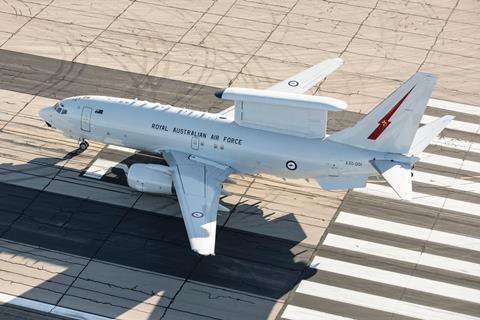Boeing will develop two new variants of its 737-based E-7 airborne early warning and control (AEW&C) aircraft for the US Air Force under a newly disclosed contract worth up to $1.2 billion.
The company and US Department of Defense (DoD) disclosed the news on 28 February, with the DoD saying Boeing is developing the aircraft under its “E-7A Rapid Prototype programme”.

“The E-7 provides a fully integrated, combat-proven, flexible command and control node that delivers multi-domain awareness in the most challenging operational environments,” Boeing says. “The E-7’s open systems architecture and agile software design enable the aircraft’s capabilities to evolve and remain ahead of future threats.”
The deal comes as a major win to Boeing, which has in recent years struggled with money-losing defence projects and troubles within its commercial aerospace business.
Boeing landed the work from the DoD under a sole-source “undefinitised contract action” with a “not-to-exceed” value of $1.2 billion, the agency’s contract announcement says. “This contract provides for the initiation of the development activities for the programme.”
Boeing will perform the work in Seattle and complete the project by August 2024, the DoD says.
Australia, South Korea and Turkey already operate the E-7, which is also currently in production for the UK. The jet – known by the handle “Wedgetail” – is based on the 737-700.
“The E-7 is a proven platform,” says Boeing E-7 programme vice-president and general manager Stu Voboril. “It is the only advanced aircraft that is capable of meeting the US Air Force’s near-term airborne early warning and control requirement while enabling integration across the joint force.”
In April 2022, the USAF revealed plans to replace some of its 707-based E-3 Sentry reconnaissance aircraft with E-7s, saying a contract award would occur in fiscal year 2023.
“The E-7 capitalises on existing commercial derivative aircraft design, certification and modification processes, allowing E-7s to be fielded to meet [US] Air Force needs,” Boeing says. “The E-7 uses a well-established supply chain which significantly reduces maintenance and logistics costs and increases mission readiness on day one.”

The USAF notes it has already established a programme management office for E-7 procurement and will use the DoD’s rapid prototyping acquisition pathway to acquire the first two aircraft of its planned fleet of 26.
Andrew Hunter, the assistant air force secretary overseeing acquisitions, says the Wedgetail will become the Pentagon’s principle airborne sensor for ”detecting, identifying, tracking and reporting all airborne activity”.
”The E-7A will enable greater airborne battle space awareness through its precise, real-time air picture and will be able to control and direct individual aircraft under a wide range of environmental and operational conditions,” Hunter says.
The USAF says it plans to begin production in 2025, with the first E-7A expected to be fielded by 2027. The service anticipates procuring the full 26-aircraft fleet by 2032.
Modernisation of the E-3 fleet will continue concurrently, Hunter notes.
“Until the E-7A is fielded, we will continue to rely on the E-3 AWACS,” he says.


























